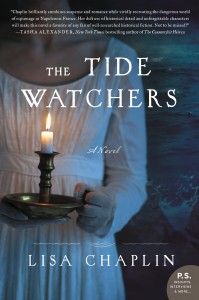Spies and Submarines in the Napoleonic Era: The Tide Watchers by Lisa Chaplin imagines a crucial mission for real-life unnamed heroes
JANE STEEN
“After seventeen years of constant happy endings, perhaps I was ready for something more realistic.” So says Lisa Chaplin, who had written twenty romance novels (under the pen name Melissa James) by the time she finished The Tide Watchers. Her mainstream historical fiction debut, set during the Peace of Amiens (March 1802-May 1803), follows the fortunes of Duncan Aylsham and Lisbeth Sunderland, who become unwillingly involved in a complex tangle of espionage activities that both foster and ultimately threaten their growing relationship.
“The truth is,” says Chaplin, “the ending I gave Lisbeth and Duncan was far happier than the real lives of most spies of the time . . . . [They were] forced to perform acts that would scar anyone’s conscience, then left to cope with the consequences of their missions alone . . . I decided an open ending belonged with both the storyline and characters, since in real life spies didn’t just quit.” She found a story behind the story while researching: “I noted in the biographies and histories of the time that though both men in positions of decision-making, and the spy rings in Britain and Europe, were named and given code names, others—who performed extraordinary service for Britain—were left unnamed.”
Chaplin wrote “about ten” versions of the novel as she wrestled with the problem of remaining true to both history and her story while writing about a milieu where identities were often deliberately obfuscated. “Using whiteboards and corkboards, I surrounded my study in maps and pictures, and most especially detailed timelines and code names for each real-life person.” She based her story around the loss of several craft from Napoleon’s flotilla at Boulogne when they sank during a test run, noting that “many papers from the . . . era were destroyed, ‘to protect those involved’ in certain delicate missions,” and positing that some of those unnamed spies were women.
Furthermore, Chaplin invented a submarine called Papillon, the fictional creation of American inventor—and admirer of Napoleon—Robert Fulton. No craft of that name actually existed, but it was a “fact that Fulton did build trial crafts before Nautilus,” the latter craft being generally considered as the first practical submarine. “It made sense that a constantly cash-strapped Fulton would create . . . perhaps a two-man boat, to attempt Bushnell’s feat before moving on to a craft the scale of Nautilus. He did this with small-scale steam engines for boats before moving on to ship-sized engines.” (Fulton’s ship, Chaplin explained, is the ancestor of today’s Mississippi steamboats.) “Also, a dedicated inventor wouldn’t damage Nautilus and its blueprints without having a model hidden somewhere from Napoleon, who, like other leaders of the time . . . would confiscate inventions and keep the profits to himself.”
After considerable research into the history of submarines, Chaplin hit the jackpot in 2011 when she visited the Jacques Cousteau Oceanographic Museum in Monaco and found, among other research treasures, “a full-scale model of David Bushnell’s ‘turtle,’ the one-man submarine Bushnell used in the War of Independence to try to sink British ships.”
 Two hours sitting in the model taking notes and photos provided Chaplin with the detail and sense impressions she needed to imagine how the two real-life, unnamed spies she’d deduced had disabled the Boulogne fleet could have managed the deed undetected. “Bushnell was unsuccessful in his great mission in 1778,” she told me, “but Fulton’s genius lay in adaptation . . . Bushnell had barely made it a mile on his own. I knew I had to make [the story] bigger, but many of the more obvious problems would remain—seasickness, the need for a bathroom, fighting the currents, etc. Having visited the area of Boulogne-sur-Mer, Ambleteuse and Audresselles, I knew how strong the currents were; they had to play a large part in the story of how the two real spies made it into La Liane, the river behind Boulogne Harbor, not once but probably twice.”
Two hours sitting in the model taking notes and photos provided Chaplin with the detail and sense impressions she needed to imagine how the two real-life, unnamed spies she’d deduced had disabled the Boulogne fleet could have managed the deed undetected. “Bushnell was unsuccessful in his great mission in 1778,” she told me, “but Fulton’s genius lay in adaptation . . . Bushnell had barely made it a mile on his own. I knew I had to make [the story] bigger, but many of the more obvious problems would remain—seasickness, the need for a bathroom, fighting the currents, etc. Having visited the area of Boulogne-sur-Mer, Ambleteuse and Audresselles, I knew how strong the currents were; they had to play a large part in the story of how the two real spies made it into La Liane, the river behind Boulogne Harbor, not once but probably twice.”
Deducing the likely story behind the history enabled Chaplin to build in several chapters’ worth of fast-paced adventures that test the mettle of Duncan and Lisbeth against natural and political enemies. She surrounded her fictional characters with larger-than-life real personalities such as Lady Georgiana Gordon and Thomas Pitt, Lord Camelford, known as the “Mad Baron,” about whom she says: “His escapades amazed me—I could barely believe it until I read it from several sources.”
Lady Georgiana and the Mad Baron are due to make a re-appearance in Blind Winter, the sequel to The Tide Watchers, and Chaplin says she has plans for at least four books. “The sheer amount of incredible things that happened in four short years, between the Rue Nicaise assassination attempt on Napoleon in December 1800 and Trafalgar in 1805, demand more than one story.” And through her fictional characters, Chaplin can pay tribute to heroes and heroines whose names will never be known.
About the contributor: Jane Steen was born in England and has lived in three countries, but still manages to hang on to the English accent. She currently resides in the Chicago suburbs with her family, but visits the UK as often as possible. Jane is a self-published author of historical fiction, starting with The House of Closed Doors, the first in a series. She’s also a runner, a knitter and designer of lace shawls, and full-time executive assistant to a cognitively disabled daughter.







